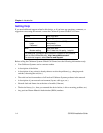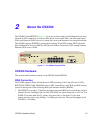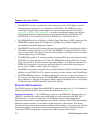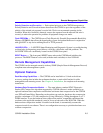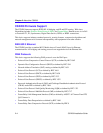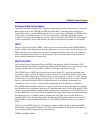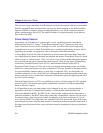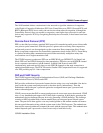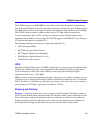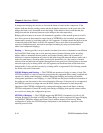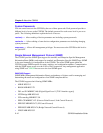
CSX200 Firmware Support
CSX200 Installation Guide 2-5
Firmware Data Compression
The STAC Electronics Stacker LZS Compression algorithm provides a minimum of 2:1 firmware
data compression for the CSX200 over PPP and Frame Relay. Firmware data compression is
supported in software on each WAN interface for line speeds of up to 256 Kbps per WPIM, which
is equivalent to four DS0 channels. To use data compression, compatible equipment (which
conforms to the applicable standards), must be in use at both ends of the WAN link. This method
of data compression is used as the default, if the hardware compression module is not installed.
HDLC
High-level Data Link Control (HDLC) protocol is used in conjunction with the WPIM-HDSL to
conserve WAN bandwidth between two compatible devices, over a point-to-point connection. The
HDLC (RAW) protocol reduces the amount of overhead information that needs to be contained
within each data packet to direct it to its destination. This decreased packet overhead provides
more available bandwidth to transfer data.
DHCP and NAT
The Dynamic Host Configuration Protocol (DHCP) and Network Address Translation (NAT)
schemes eliminate the expense of purchasing limited public IP addresses for each client on a local
network, and the need to re-configure a client if it is moved to a different network.
The CSX200 acts as a DHCP server that lets individual clients (PCs, network equipment) take
turns using a range of private IP addresses (often referred to as local IP addresses), and provides
optional secondary setup features for these clients on a per-port basis. A private or “local” network
is referred to as a sub network that is using private or “local” IP addresses. An “outside” network
refers to a Wide Area Network (WAN) commonly known as an Internet. An Intranet is an
“Internet” in use on a facility or campus where registered public IP addresses are required.
The CSX200 distributes these addresses on a first-come-first-served basis, dynamically assigning a
local IP address to an individual client (from 253 available addresses). This local IP address is then
“leased” for a predetermined amount of time, configured for a particular port. Each Ethernet port
provides DHCP services for one Class C subnet and secondary setup features for individual clients
that support the use of a default gateway, domain name and WINs server. On the Wide Area
Network (WAN) side, the Network Address Translation (NAT) routing scheme lets clients with
local IP addresses use the public IP address(es) of the CSX200 WAN interface(s) to access the
WAN.
NAT lets several DHCP clients on a sub network connect to WAN clients by letting the DHCP
clients share a single public IP address. The NAT scheme modifies the IP headers and addresses,
and the selected fields in upper layer protocol headers.






